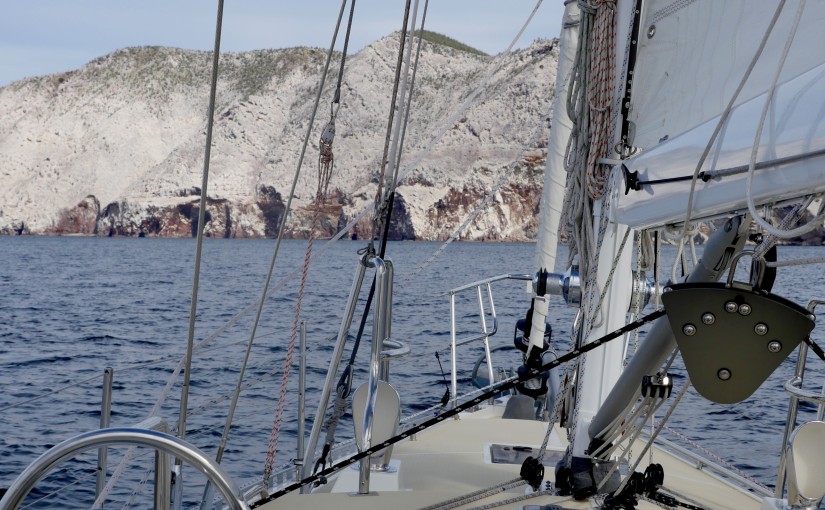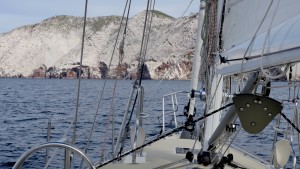The midmast view from the elevated fuel dock, looking down at Allora made me want to get more comfortable climbing the mast. She shimmered in the bright lights set against the dubious waters of the strange little harbor at this French mining town, Santa Rosalia. Lyndon, captain of the sailing vessel, Moon (a beautiful 42 foot Hinkley with generous cockpit, tall, tall mast and navy blue hull), a marine biologist, or something like that, mused about the chemicals on the periodic table that neighbor the copper mined here for decades. Arsenic, lead. What else would have settled in the mud inside this industrial looking harbor, carved out of the shoreline with its grey stone breakwater? In a square, the wreck of a mid-size schooner still nestled half sunk and rotting in one corner. We topped off our forward tanks, backed away in the windless water and motored out around the ludicrously outsized yellow buoy that marks the shoaling on the east side of the entrance.
We did not expect a breath of wind for the planned 77 mile trip up to San Francisquito. The forecast showed zero, but within half a mile we had 8 to 15 out of the west, which took us out passed the first point, then died. We could smell smoke from the shore, but couldn’t’ see the fire. We started up the engine and Diana took the first watch, turning the engines off less than an hour later as a nice NW breeze settled in convincingly. We will probably keep saying it, but the bioluminesence was off the charts. Really. The waves slipping off the bow lit with green lines of fire that was bright enough to light up the sails. The hydrogenerator on the stern churned a comet tail in our wake. It was mostly overcast. Diana turned on the red light in the cockpit to record our position, speed, course over ground, and wind conditions. We weren’t moving super fast, ultimately averaging about 4 knots an hour as things slowed down a little on my watch. The best course we could make without tacking sent us straight north up the Sea headed directly for what initially looked like a little island, Isla San Pedro Martir. Diana woke me at three thirty, as usual going later than she should on her watch. She said she would have kept going but was concerned I might be disappointed to miss the night sailing. I promised to wake her at sunrise if it was as spectacular as it promised to be. The sky was now about 5/8 which is how we list cloud cover in the log.
Before she went to sleep she set me up with our, now traditional, mint tea. She had also dug out my favorite chocolate cookies (a little thing at home in our pantry, a much bigger event here tucked into Allora’s tightly packed nooks and crannies) and set me up with a big loaf of sweet bread from the famous French bakery in Santa Rosalia (the one just a few blocks up the one way “up street” from the steel Gustav Eiffel designed church). The bread kept me awake, though it tasted like everything else from the bakery, not particularly French, a little underwhelming like the landmark church, set among the colorful clapboard buildings of the little mining town. A better set of words than reality provided, but charming nonetheless.
When I couldn’t eat anymore of the sweet doughy bread, which reminded me of sneaking raw pie crust as a kid, I clipped my harness in on the starboard padeye to gaze at the bioluminescene (which deserves a better, more magical and easier to spell name). By now the moon was peeking out on our port side, but the green lit waves (as bright as our running lights) on the starboard was mesmerizing. I couldn’t help be stunned at this tiny glimpse of infinity. If we could sail for miles in the sea, and everywhere the water could be filled with countless millions of these glowing little creatures, how many of them could there be? I looked up at the stars shining in the gaps of the thinning clouds. Okay, right? Now the devout among my friends must forgive me, but really, in a universe as vast as this, that crushes human names for numbers (except in the abstract), how can our puny religious fictions, with all their thou’s and begats, come close to the spiritual gigantic-ness of the real unknown, even the tiny slice of its awesomeness we can see with our earthbound eyes. This is why I’m an atheist, so I set no limitations on my awe.
As the eastern sky paled slowly with dawn, visible to my darkness adjusted eyes almost an hour before I expected it, the wind began to slow down. So far in our experience, when the wind drops below 4 knots, it also starts swinging around the compass and with any swell at all, the boom rocks back and forth, the jib fills and collapses. It’s a frustrating mess. But the Sea of Cortez was mirror flat, barely ruffled by the remaining breeze, and the wind dropped down to three knots, but stayed constant from about 300 degrees. Allora kept moving, slipping along at 2 knots or so. Because we were not on a direct course to San Francisquito as it was (pointing against a NW wind) our computer calculated (and recalcualted constantly) that we would make it there, not the next day but the following, sometime around three in the morning at this veloctiy made good (VMG). Still, I didn’t really feel like starting the engine. Diana was in a deep sleep, and there just didn’t seem to be any compelling reason that we needed to be moving faster. After all, we were, as we always are, already home.
With Allora moving so slowly now, just slipping through the sea, the wavelets off the bow, rippled outward, luminous caligraphy in the slick water. It was also beautifully quiet, no sound from the sails, Allora barely whispered. We’re always floating (the laws of entropy willing!), but now we really floated, like a bird gliding on a light breeze. Sound travels on still water, so the whale I heard blow could have been right by the boat (I could hear that weird phasing whistle of the inhale), or several hundred yards away in the liminal ocean. I stared, but I could not see even a dark shadow. When it blew again, I woke Diana. Whale!
We sat at the bow, listening intently and staring as the sunrise quielty gathered light and Allora glided northward. We never saw the whale, and it must have been several, which blew and splashed along our path until it was light enough to see, and then they slipped away into the subterranean blueness and the wind came up again and ushered us onward.
We arrived at Isla San Pedro Martir, which has another name in the local indian language, and a very special spiritual significance. A rock like a mountain from Montana, dusted white with guano, with dark green trees atop which looked like pines. With deep caves in the massive stone along the shoreline and crazy currents in the deep water known for giant Humboldt squid and the Sperm whales which feed upon them. Diana did her best to drift Allora along the 200 foot contour and I jigged with an iron lure hoping for Yellowtail or Cabrilla. Diana suggested that when we have internet again I watch a video on jigging, since I was basically making it up. We had no luck and finally sailed around the south side of that magnificent island.
San Franscisquito was still almost directly upwind of us, but we realized, Isla Tiburon was straight along our course, so with nothing pressing us but the need to find a good anchorage for the predicted northwest blow, we continued our northward diagonal crossing of the sea. The wind had come up into the gusty teens. Diana wisely proposed setting the solent (the smaller of our two headsails), and we scooted along with a knot of current in our favor at over 8 knots toward Isla Tiburon. We should have had lunch when the wind was 8 knots, but Diana made sandwhiches with bread from the french bakery (think Baja Wonder Bread and you’ll have a good idea of this famous ‘pan’) and we ate them bracing ourselves on the starboard bench. Being on the low side, the settee was perfectly set for a nap, cradling me nicely as the waves and wind built. An hour later it was Diana’s turn to wake me with, ‘Whale!’ Amazing how hard it is, rising from a nap, to negotiate a boat heeled hard over and pounding against a steep chop. The whale Diana had seen, must not have known we were there, because when we surprised it (just off our port side bow), it slammed its tail as it dove and left a massive swirl of churning ocean behind.
We reefed and sailed hard for Tiburon, rejecting the first anchorage and motoring around the rocks to another, better protected one, where we dropped anchor at Ast Ahkeem or Hast Hakim, depending upon which reference you use. The sunset was as stunning as the sunrise, and we slept soundly waiting all night for the predicted north wind that never showed up. Clear skies in the morning and a pefect heavy dew to use to wipe the salt from Allora. Pastries from the french bakery, which have indistiguishable sweet fillings with crust or buns that must be poured like everything else there for the giant vat of dough that gives Santa Rosalia its dubious fame.


